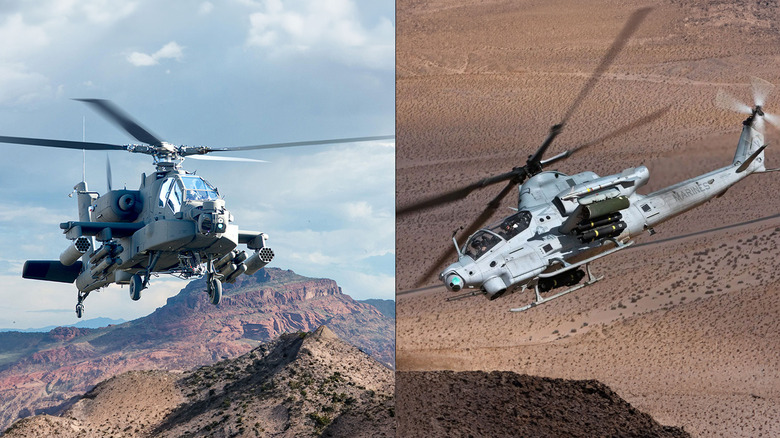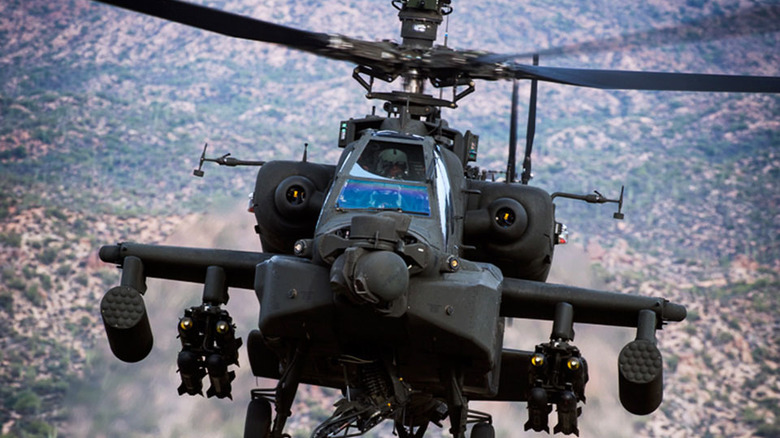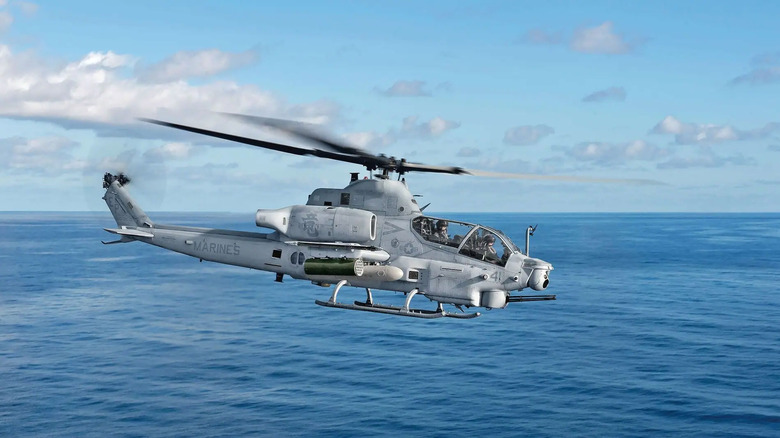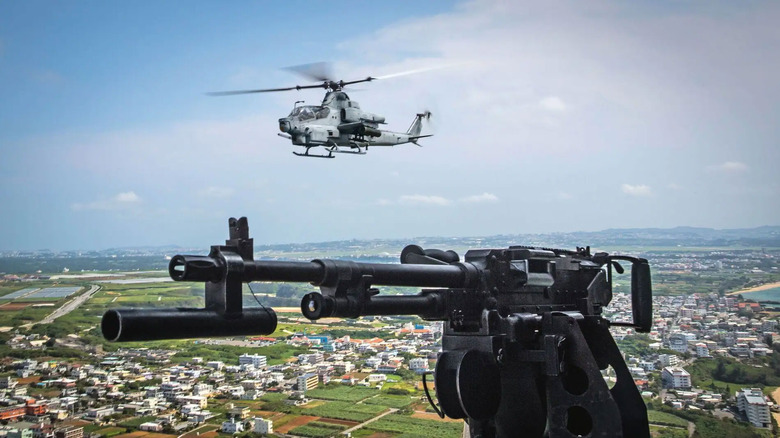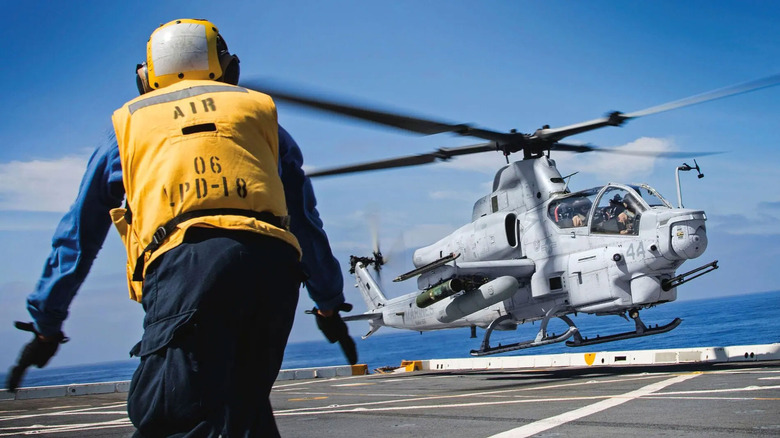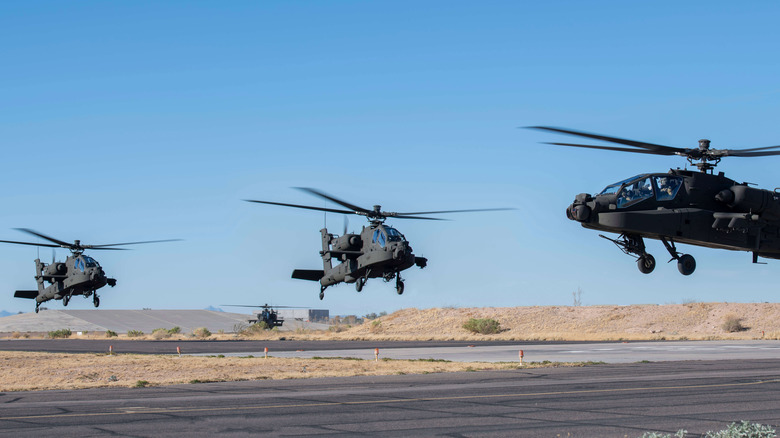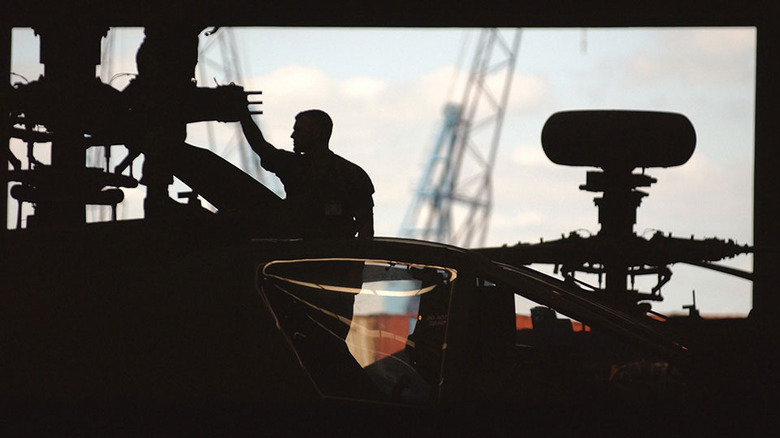AH-64 Apache Vs. AH-1Z Viper: Which Is The Ultimate Attack Helicopter?
In terms of military attack helicopters, perhaps no two aircraft are as iconic as the United States AH-64 Apache and AH-1Z Viper. Both helicopters have been critical components of American military air dominance and are examples of technological and mechanical quality and innovation. Bell's AH-1Z Viper is utilized by the United States Marine Corps (USMC), while Boeing's AH-64 Apache remains the U.S. Army's primary attack helicopter.
It's a tough comparison to make when considering which of the two legendary helicopters serves as the ultimate attack platform. Militaries across the globe are currently using both aircraft, and each boasts modern onboard technology as well as a powerful array of weapons. Each helicopter has been used in various conflicts and has been largely successful on the battlefield. Though both the AH-64 Apache and AH-1Z Viper are more than capable military helicopters, the aircraft differ in various ways, each possessing different hardware and its own unique history.
What is the AH-64 Apache?
The AH-64 Apache is a two-crew military attack helicopter developed by Boeing and has been in service with the United States Army since 1984 with its original iteration, the AH-64A. Previously manufactured by McDonnell Douglas, which merged with Boeing in 1997, the Apache is arguably the most iconic military helicopter in history and has been featured in many movies and TV shows.
The AH-64 Apache is used primarily as an anti-armor air-to-ground attack platform. Using advanced technology and a suite of powerful ordinances, the aircraft can track down and engage enemy threats regardless of the time or weather conditions.
Over the years, the Apache has seen significant upgrades and variations to make it the modern military attack helicopter it is today. Today, the latest iteration of the craft, the AH-64E "Guardian," serves as the United States Army's primary attack helicopter. This model improved upon the previous AH-64D "Longbow," which was used by the U.S. Army and its allies since the 1990s.
The AH-64 Apache has seen action in several operations, including Operation Desert Storm and peacekeeping operations worldwide. Today, the AH-64 Apache helicopter services several militaries, including countries like Egypt, Japan, and the U.K., among many others, with over 1,200 of the craft currently in service.
What is the AH-1Z Viper?
The AH-1Z Viper is a two-crew military attack helicopter developed by Bell Textron. The four-bladed helicopter replaced the United States Marine Corps (USMC) two-bladed Bell variant, the AH-1W Super Cobra. Part of the H-1 Upgrade program, which was started in 1996 by the U.S. Department of Defense, this initiative sought to update the AH-1W aircraft into a new attack helicopter that could provide anti-armor, air-to-air, reconnaissance, and overall fire support under a variety of weather conditions.
Before this, Bell had already been delivering helicopters to the United States military since 1959, with the original iconic UH-1 Iroquois, or "Huey," used in the Vietnam War. The first AH-1Z Viper would take its first flight in December 2000, with the helicopter reaching operating capacity in February 2011. The new four-rotar design of the plane helped with the aircraft's stability, reducing vibrations in the hull by up to 70 percent from previous Bell Helicopter models, which had two-rotar designs.
However, the AH-1Z Viper improved upon the AH-1W in a few notable ways beyond the additional helicopter blades, including an upgraded transmission, a four-bladed tail rotor, an integrated glass cockpit, and enhanced landing gear. Because of its durability and useability, the Viper is still a staple asset to the United States Marine Corps for a variety of reconnaissance and attack missions since being introduced.
AH-64 Apache vs. AH-1Z Viper engine and ordinance comparisons
The AH-1Z Viper is over 58 feet long and 14 feet high, is powered by two General Electric T700-GE-401C turboshaft engines, and can reach speeds of 200 knots, or approximately 230 miles per hour. Similarly, the AH-64E Apache is also a two-person twin-engine aircraft that uses General Electric T700 engines but utilizes the 701D model.
The main difference is that the Apache's max speed is a bit slower at 150 knots or just under 173 miles per hour, making the Viper the faster helicopter. The Apache is also around 10 feet shorter and one foot taller than the Viper.
The Viper has one main M197 20mm three-barreled Gatling cannon capable of firing 1,500 rounds per minute, Hydra 70 or APKWS II rockets, AIM-9 Sidewinder air-to-air and AGM-114 Hellfire air-to-ground missiles. The Apache's main machine gun is larger and more devastating to ground units, utilizing the 30mm M230 chain gun, though it does fire slower at 600–650 rounds per minute. With a similar ordinance, the Apache comes equipped with Hellfire air-to-ground missiles and smaller 2.75-inch Hydra-70 missiles.
The huge difference between the two attack helicopters is that the Viper, while used primarily in an air-to-ground capacity, also has air-to-air combat capabilities, arguably making it the better solution for missions with enemy air resistance. Another big difference in design is that the Apache has wheels, whereas the Viper uses skids, making taxiing with the Apache possible.
AH-64 Apache vs. AH-1Z Viper technology and cost comparison
Both attack helicopters boast modern and robust onboard systems that aid pilots with real-time combat data during flight. The Apache AH-64E comes equipped with the Lockheed Martin Modernized Target Acquisition Designation Sight/Pilot Night Vision System (MTADS/PNVS). This improvement over the prior variations of the Apache enhances visibility at night and during adverse weather conditions. MTADS/PNVS has been used by the United States Army since 2005.
On the other hand, the Viper uses the Thales "TopOwl" helmet-mounted sight and display system, offering an advanced 180-degree view around the pilot with important combat data transmitted through the head-in-display. The Viper also comes equipped with HD FLIR technology via the Lockheed Martin sight system (TSS) to help pilots interpret their environment. The first tests for the TopOwl occurred in 2012.
According to documents made available by the U.S. Department of Defense Comptroller in 2023, one flight hour for the AH-64E Apache costs around $6,440, with the older AH-64D helicopter being more expensive to maintain at $9,476 per flight hour. The AH-1Z Viper, on the other hand, comes in right between the two models of the Apache, costing $7,465 per flight hour. Though marginal differences add up over time, both companies have reduced costs over the craft's lifespans.
The future of the AH-64 Apache and AH-1Z Viper
The AH-64 Apache will be utilized by the U.S. Army well into the future. According to a July 2023 Army press release, the AH-64E is getting major software enhancements via Version 6.5, which will upgrade the software on the helicopter.
In addition, the new Apache variations will undergo modernization efforts to integrate the new and improved General Electric ITEP engines, which will ultimately provide 50% more power and 25% better fuel consumption to the AH-64E Version 6.5 models. The V6.5 improvements are scheduled to be completed in 2025, with the first retrofitted aircraft entering the field in 2026.
The 189th and last AH-1Z Viper was delivered to the USMC in 2022 after logging over 500,000 flight hours for the Marine Corps. That said, the helicopters will likely continue to be in service for decades, with Bell creating Vipers for the Czech Republic and Bahrain.
The Structural Improvements and Electrical Power Upgrades (SIEPU) program will continue to provide upgrades to both the AH-1Z and UH-1Y aircraft in the United States over the next few years. Though the Marines don't currently have a replacement for the Viper, they are replacing their heavy lift platform, the Sikorsky CH-53E Super Stallion, with the imposing CH-53K King Stallion.
The AH-1Z Viper has better technology than the AH-64 Apache, for now
With greater combat capabilities via its air-to-air missile systems, faster speeds and more maneuverability, and enhanced onboard combat software, it's hard to argue that the AH-1Z Viper isn't the ultimate attack helicopter at this very moment. That said, enhancements and improvements via the AH-64E V6.5 Apache will bring the terrifying aircraft up to spec with the Viper in terms of modern technology, which will make the Apache the dominant aircraft.
Ultimately, both attack helicopters are incredibly comparable, and the best option depends on the operation they're being used in and a pilot's specific training. Because both helicopters are used in different branches of the military, it's unlikely many people in the world have piloted both, making points of comparison somewhat pointless in the end.
However, the Army's Apaches will continue to be manufactured and improved over time, while the Viper has seen the end of its road, at least in terms of the United States military. The United States awarded Boeing with a $1.9 billion order for more Apaches as recently as 2023, while the last AH-1Z Vipers have already been shipped and delivered, proving that being the best doesn't equal longevity. Boeing plans on continuing to improve the aircraft into the 2060s.
In total, the iconic AH-64 Apache helicopter has over five million flight hours, 10 times the number of the Viper, showing how critical both aircraft are to America's military superiority.
